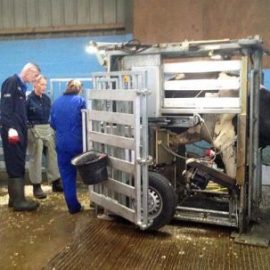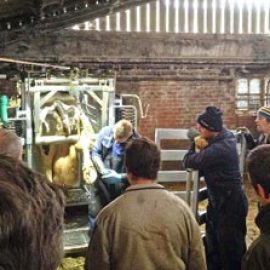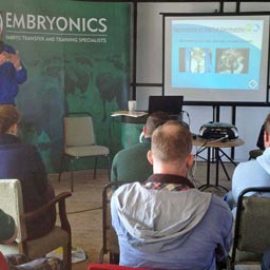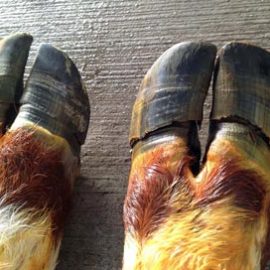Twenty-five years on and the Dutch are Flattered.
Twenty-five years on and the Dutch five-step foot trimming method remains the gold standard.
Pieter Kloosterman and Ceila Maddock examining a Dutch foot diploma candidate.
Built on a vast wealth of scientific research, experience and excellent results backing up its solid methodology, it has treated, very successfully, millions of cows throughout the world and remains the most widely used and most successful trimming method.
It is said imitation is the highest form of flattery and, with several bodies throughout the world claiming a “modified Dutch method”, the Dutch are extremely flattered. However, it appears these modified methods are only a slightly modified variation. Comments made about the modified methods range from “they are the same” and “an updated version” to “only a small difference”.
Some trimmers have suggested the modifications are, in most cases, so small, they are of no benefit to the cow. It has also been suggested the modified method encourages too much horn to be trimmed off, reducing the overall weight-bearing surface.
This reduced weight-bearing area, when combined with the amount of time spent by our modern cow walking on wet concrete, puts too much pressure on the remaining weight-bearing area, causing excessive wear or extra bruising and damage to the white line.
Development of professional foot trimming course
Twenty-five years ago, Embryonics introduced the Dutch five-step foot trimming course to the UK, after attending it in the mecca of foot trimming – the Dairy Training Centre (DTC) in Friesland, the Netherlands.
A hydraulic crush in use during the professional course.
Embryonics and the DTC, which work with the Utrecht University Faculty of Veterinary Medicine, embarked on a partnership that has evolved, incorporating new developments and continuing to change the future of cattle foot care in the UK.
Pieter Kloosterman – world expert on cattle foot care and the Dutch five-step foot trimming method, and head of the team of instructors at the DTC along with Embryonics – launched the first four-day professional foot trimming course in the UK teaching the Dutch five-step method as a way of improving bovine feet, thereby reducing lameness and improving welfare.
This course is as popular now as it was then and remains a leader in cattle foot care. It is recognised widely by professional foot trimmers, vets, herd managers and herdsmen worldwide, and it has forged a highly respected profession of foot trimmers.
Recently re-endorsed at the National Association of Cattle Foot Trimmers (NACFT), it remains the recognised standard, which, when performed correctly, rebalances cow feet to the highest standard – a standard that has 25 years of practical, on-the-ground evidence to prove and support its benefits. The DTC was, and still is, the centre of cattle foot trimming; it has the longest established trimming school with the most experienced instructors.




How it started
Twenty-eight years ago, the five-step Dutch method was being talked about as the way to trim lame cows. Eager to learn, a group of interested vets and foot trimmers were rounded up via an advert and set off for a course in the Netherlands. At that time, almost all the lameness work in cattle was done by the local vet and routine trimming was non-existent. The course was a total eye opener. The theoretical session – developed at the Utrecht University Faculty of Veterinary Medicine by vet Toussen Raven, in conjunction with very close and extensive work and research done with the DTC practical school – was superb.
The combination of the weight-bearing information gathered by using pressure plates, the scientifically evaluated gait and the anatomical make-up of horn formation explained the logical weight-bearing areas of the claw. The information was then combined and analysed to develop the shape of the balanced claw.
A theoretical session during the professional course with Pieter Kloosterman.
To teach the subject to a beginner, it had to be put into an easy-to-follow method that could be taught in a logical, practical fashion for all to understand – hence, the Dutch five-step trimming method was born.
Guidelines for the toe length, sole thickness and all the measurements had to be developed and included in the narrative notes used in the teaching of the theory part of the course where the understanding of the foot is learned before practical trimming begins. However, any measurements are not cast in stone and, at certain times, cannot apply; this is where the practical element of the course is vital.
These variations can only be understood and taught on the live animal, where the variation can be seen and understood. Hence, reading about the Dutch method doesn’t make someone a trimmer.
Indeed, not all the cases that don’t fit the standard can be seen on all courses; hence, the trimmer needs to begin trimming ideally along with an experienced trimmer, so when these cases are seen, the new trimmer can look on the experiences of his or her companion to guide him or her on how to trim.
The NACFT checks days are an ideal time to discuss these complicated and unusual cases, and pictures can be taken along and shown on the day, so all attendees learn from the general discussion taking place.
Trimmers who wish to progress to fully licensed trimmer status can proceed to take their examination, where their finished balanced foot can be assessed and marked to make sure their trimming results in a properly balanced foot.
Cattle foot trimming has now become a regular event on farms. Professional trimmers are engaged by many farms to carry out the majority of the preventive and curative trimming, and equipment has developed that allows the trimming to be performed in a less arduous and more efficient way.
Coupled with the advances made in treatment and prevention, trimming today is far better placed to produce a happier, more productive cow. Since the introduction of the course, it has developed and changed so, today, it incorporates all the up-to-date requirements to deal with the modern herd.
However, the solid foundation of the five-step method remains the heart of the course, allowing the student to acquire the practical skill to trim correctly.


Changes
All the developments are incorporated into today‘s teaching on the professional foot trimming course. These changes include:
• discussions on up-to-date treatments, such as NSAIDs
• the hydraulic crush is used and the electric trimming grinder demonstrated and used
• the important topic of locomotion scoring and its benefits are covered
• insurance and other legal issues for the professional trimmer are covered
• computerised recording programs, which can aid record keeping and can be used to analyse lameness, are demonstrated
An example of lameness conditions discussed during the course – the results of a severe laminitis attack.
The modern crush has changed beyond recognition, becoming more efficient and user-friendly. They are fully hydraulic, which makes trapping the cow and lifting the feet easier work. Most of the crushes lift the cow so the trimmer is working at a more comfortable height, which is better for its health.
Cows are restrained securely to allow the trimming to be done with the electric grinder. This has been one of the main developments, making the overall trimming a lot easier and allowing greater cow numbers to be trimmed in a day.
Many types of hydraulic crushes are available – each with its own system. Also, as with a car, each trimmer has his or her favourite.
Computerised systems are used for recording the findings of the trimmed cows. The program demonstrated on the courses allows each foot of each cow to have records attached and analysis to be done. Invoicing at the end of the trimming session can be done very easily.
When the trimmer revisits the farm and is presented with the same cow, its records appear automatically, so previous relevant history of lameness can be seen. This record can also be used to help identify cows to breed from and help with culling decisions.
The course majors on the use of the knife, as it is imperative for a trimmer to master this tool.
It is also the tool that allows the student to grasp the Dutch five-step method, learning how to correctly trim to rebalance the foot. Using the knife equips the student with the understanding of how the well-balanced foot is attained. Ample opportunity exists to use the electric grinder, which is best used initially on feet obtained from the abattoir; this ensures any student who has not used an electric grinder before masters its use before proceeding on to a live cow.
Numerous types of trimming discs exist and their differences are discussed and students guided to the one most suited to their needs.
Discs can have different numbers of blades and the cutting blades can extend round to the side of the disc, as well as the flat surface.
Locomotion scoring has become a key part of monitoring lameness in the herd. It helps identify the cases in need of attention by the trimmer and the records can be analysed to assess the level of lameness in the herd and monitor progress, reducing the lameness incidence if it is too high.
During the 25 years, the course has evolved as developments have materialised, so it continues to deliver the requirements for the vet, professional cattle foot trimmer and herdsman to deliver the best trimming and care to the cows.


